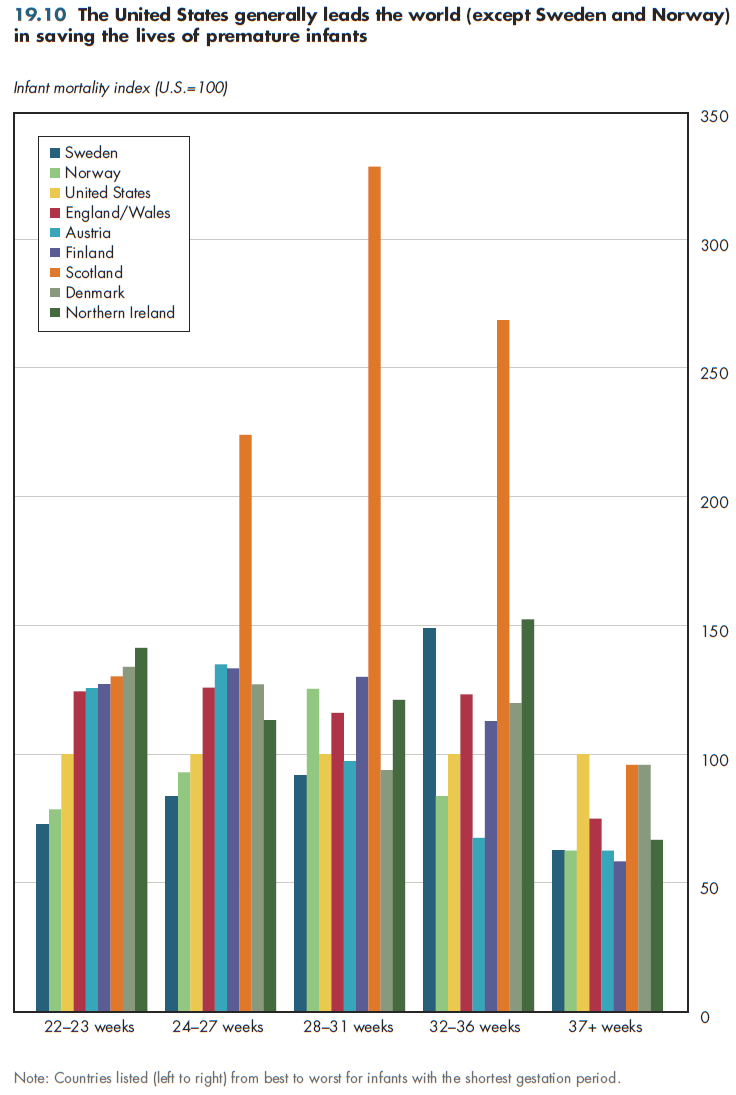Download PowerPoint versions of figure.
Inside Collection (Book): American Health Economy Illustrated
19.10 US Ranks 3rd in the World in Saving Premature Infants' Lives
Summary: Few countries match the performance of the United States in saving the lives of pre-term infants. The higher rate of pre-term births in the United States is an important contributor to its low international ranking for infant mortality overall.
The United States ranks poorly in terms of infant mortality rates, but this too says little about the performance of its health care system. The United States has the third-highest infant mortality rate in the OECD. This rate is somewhat overstated due to differences in statistical methods for measuring infant deaths. The United States is one of only eight countries that count extremely premature infants as "live births," even though they have extremely low odds of survival.
More important, compared with most other industrialized countries, the United States has a much higher rate of premature and/or low-birth-weight infants. Although adequate prenatal care certainly can influence such rates, many other social factors also contribute. For example, low-birth-weight infants are disproportionately born to mothers from disadvantaged socioeconomic backgrounds. Adolescent pregnancies also are more likely to result in a premature birth. Even though it has been declining, the U.S. teenage birth rate far exceeds that of other G7 nations. Maternal smoking, and drug and alcohol use during pregnancy also increase the odds of a low-birth- weight infant.
A fairer comparison, therefore, examines how well the medical system performs in keeping alive infants of a given length of gestation. For all birth categories before full term (37+ weeks), the United States ranks second or third among the nine countries for which comparable data exist (figure 19.10). Unfortunately, the United States and the UK are the only G7 nations on this list.

The ability to save premature infants has increased greatly over the past few decades. For white infants, for example, infant mortality steadily declined between 1983 and 2004 despite a 20 percent increase in the percentage of such infants falling into the low-birth-weight category. This reflects sizable investments in (and wide diffusion of) neonatal intensive-care units. Careful studies suggest that since 1960, the 70 percent decline in mortality for low-birth-weight infants born in the United States was almost entirely the result of improved medical care.
Downloads
References
- MacDorman MS and TJ Mathews. Behind International Rankings of Infant Mortality: How the U.S. Compares with Europe. National Center for Health Statistics Data Brief No. 23. Hyattsville MD. National Center for Health Statistics 2009.
Collection Navigation
- « Previous module in collection 19.9 US Leads the World in Life Expectancy
- Collection home: American Health Economy Illustrated
- Next module in collection » 19.11 US Cancer Patients Have Better Chances of Survival among Industrialized Nations
Content actions
Give feedback:
Download:
Add:
Reuse / Edit:
Twin Cities Campus:
- © 2012 Regents of the University of Minnesota. All rights reserved.
- The University of Minnesota is an equal opportunity educator and employer. Privacy
- Last modified on Sep 24, 2013 3:45 pm -0500









